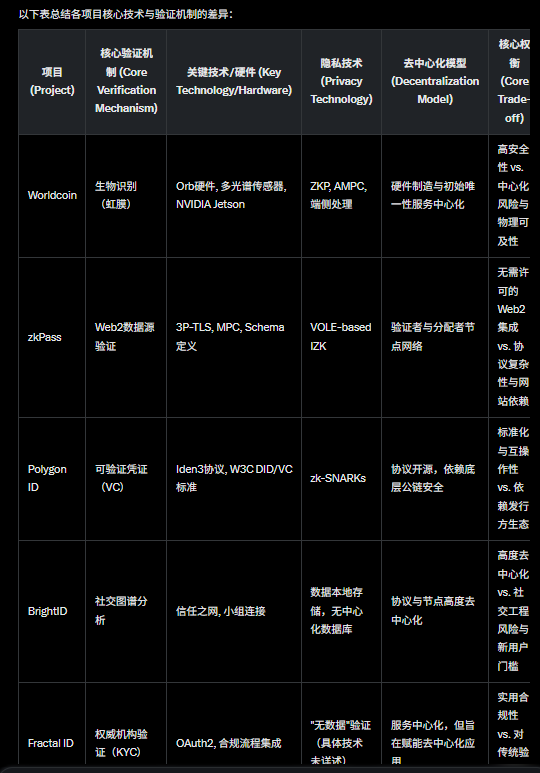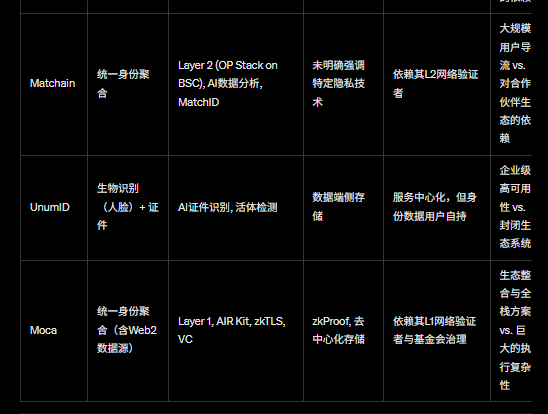Catching Moca Chain in smart threads again ( ꈍ◡ꈍ)
Inspired by @Moca_Network's Moca Chain, I have recently explored 8 DID projects (@worldcoin, @zkPass, @PrivadoID, @BrightIDProject, @Fractal_ID, @matchain_io, @UnumID, @Moca_Network, etc.), systematically analyzing their technical paths, market strategies, and differentiated positioning.
1. From the perspective of core technology paths, different DID projects choose entirely different "personality proof" methods, which determine security, decentralization, and user experience:
Biometrics (Worldcoin): The Orb hardware iris scan theoretically has strong resistance to witch attacks, but it relies on centralized hardware, raising issues of physical accessibility and trust.
Social Graph (BrightID): Analyzes interpersonal relationships to identify real users, highly decentralized, but vulnerable to social engineering attacks, with a high trust threshold for new users.
Data Source Verification (zkPass/Moca): Utilizes Web2 data (such as bank websites) transformed into credentials through zkTLS/3P-TLS, leveraging existing trust systems, but dependent on website stability and technical complexity.
2. On the other hand, I compared the privacy protection models of each project, although all projects claim to protect privacy, the paths to implementation and trust assumptions vary significantly:
Data Ownership and Control:
Device-Centric Model (Worldcoin, BrightID, UnumID): Core data (such as biometric features, social connections) is encrypted and stored on user devices, reducing the risk of exposure from centralized servers.
Protocol Intermediary Model (Polygon ID, Moca): Adopts a VC model, with privacy protection relying on protocol cryptographic design (such as ZKP), ensuring that data is not leaked during the verification process.
Centralized Risk Assessment:
Worldcoin: Risks are concentrated at the hardware level, with Orb manufacturing and firmware updates led by Tools for Humanity, and early uniqueness comparison services being centralized, although there are plans to decentralize through AMPC, it is still in the early stages.
zkPass: Risks lie in the network of validators and allocators; if the network lacks sufficient decentralization or nodes collude, it may affect neutrality and censorship resistance.
Moca: As a new L1 public chain, the early validator node set may be centralized, and the Moca Foundation has significant power over protocol upgrades and fund allocation, requiring attention to the decentralization process of governance.
BrightID: The most decentralized architecture, with risks dispersed across the social graph, but the weakness lies in whether the graph can resist systemic contamination.
3. Moca's differentiated advantages and challenges (ahem, after all, I am a Moca Holder, so I want to talk more):
Moca Chain (L1) vs. World Chain (L2):
Moca chooses to build its own L1, possessing protocol sovereignty, allowing for deep optimization of identity applications; Worldcoin opts for L2, inheriting Ethereum's security but limited by underlying constraints. Moca believes the identity layer should be a sovereign infrastructure, while Worldcoin relies on the most secure settlement layer.
AIR Kit vs. Polygon ID:
Both provide VC toolkits, but Polygon ID is more pure and chain-agnostic, emphasizing W3C standards and interoperability; AIR Kit is more vertically integrated, deeply tied to the Moca Chain and Animoca ecosystem, offering out-of-the-box features like zkTLS and account abstraction. Developers choose Polygon ID for flexibility and AIR Kit for a one-stop solution and ecosystem access.
Moca (zkTLS) vs. zkPass:
Both bridge Web2 data, with zkPass focusing on the protocol and relying on an independent validator network; Moca uses zkTLS as an AIR Kit module, leveraging its own L1 network for verification, functioning more like a platform, while zkPass is a lightweight professional tool.
4. Finally, from a more macro perspective, let's discuss the ecosystem and market positioning comparison:
Consumer-Centric (B2C): Worldcoin rapidly acquires a massive user base through WLD token airdrops, establishing network effects.
Developer-Centric (B2D): Polygon ID serves developers, providing tools and protocols to indirectly acquire users.
Enterprise-Centric (B2B): Fractal ID and UnumID target enterprises, addressing compliance and KYC pain points.
Ecosystem-Centric (B2B2C): Moca and Matchain collaborate with brands/ecosystems (like Animoca, PSG) to acquire end users in bulk.
In summary, decentralized identity is at a vibrant and uncertain crossroads. It is no longer a distant vision but a fiercely competitive reality composed of diverse technologies and business models. Moca's "full-stack" model is the boldest bet in the DID field, ambitious and preparing for the Hong Kong government, integrating advantages like VC, zkTLS, and account abstraction. If it truly succeeds, @tylerdurden88, 10B might just be the starting point.



8.33K
48
The content on this page is provided by third parties. Unless otherwise stated, OKX is not the author of the cited article(s) and does not claim any copyright in the materials. The content is provided for informational purposes only and does not represent the views of OKX. It is not intended to be an endorsement of any kind and should not be considered investment advice or a solicitation to buy or sell digital assets. To the extent generative AI is utilized to provide summaries or other information, such AI generated content may be inaccurate or inconsistent. Please read the linked article for more details and information. OKX is not responsible for content hosted on third party sites. Digital asset holdings, including stablecoins and NFTs, involve a high degree of risk and can fluctuate greatly. You should carefully consider whether trading or holding digital assets is suitable for you in light of your financial condition.


